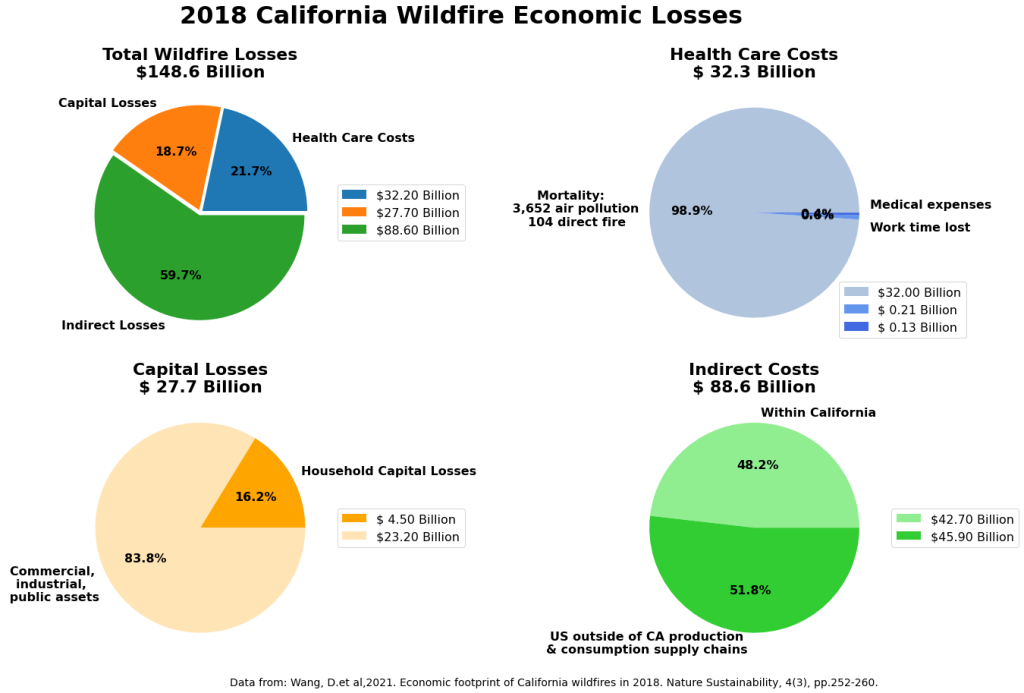
Health
Wildfires across California in 2018 produced $7.8 billion in estimated health costs in the Bay Area, upticks in hospital admissions, and an increase in polluted air. The 2020 wildfire season also brought prolonged unhealthy air quality to the region; the monthly maximum Air Quality Index (AQI) was above 100 (considered unhealthy for sensitive groups) for three straight months as measured by multiple monitoring stations across the region.
Climate
Beyond the human and societal impacts, wildfires also affect the Earth’s climate. Forests in particular store large amounts of carbon. When they burn, they immediately release carbon dioxide into the atmosphere, which in turn contributes to climate change. After burning, forests also release carbon dioxide more gradually through decomposition (source https://www.epa.gov).
Air pollution
Large wild fires contribute smoke, particles, and harmful chemical compounds to air pollution. Limiting the development of large wildfires will therefore also contribute to the reduction and areal containment of air pollution. The importance of monitoring air pollution is also recognized by the three space agencies NASA (TEMPO), ESA (Sentinel), and KARI from Korea (GEMS) who collaborate on a global monitoring system for air pollution. The Tropospheric Emissions: Monitoring Pollution (TEMPO, https://tempo.si.edu/index.html) mission is scheduled for launch in April 2023 and will cover the whole US and parts of Canada and Mexico with about 2×5 km spatial resolution.

Cost
The total economic impacts of a wildfire go well beyond the cost of damages, as they include health costs and indirect losses due to power shut-offs, business closures, travel cancellations, supply chain disruptions, among other costs. Large wild fires create huge damage to homes, infrastructure, and forests. California’s largest recorded wildfires by acreage have all occurred since 2017. When counting insured losses, the 2020 wildfire season is estimated to have produced between $5 billion and $9 billion in destruction, after wildfire seasons in 2017 and 2018 that each produced more than $10 billion in insured losses (http://www.bayareaeconomy.org/report/the-true-cost-of-wildfires).
The 2017 North Bay complex of wildfires in Napa and Sonoma Counties, caused a steep drop in overall employment and a spike in unemployment claims. Immediate employment losses were felt most by the leisure and hospitality sectors, and there were corresponding drops in hotel tax revenue and Sonoma County Airport passenger activity.

Besides the cost of lost property there is also the substantial cost of fighting wild fires and contain their extent and spread. Over the past few decades, the United States has routinely spent more than $1 billion per year to fight wildfires, including $2.3 billion in 2020 (Source https://www.epa.gov). These efforts have resulted in the deaths of more than 1,000 firefighters since 1910.
Water resources
Wildfires can compromise water quality both during active burning and for months and years after the fire has been extinguished. Burned watersheds are prone to increased flooding and erosion, which can negatively affect water-supply reservoirs, water quality, and drinking-water treatment processes (https://www.usgs.gov).
Large wildfires have increased in size and frequency in the western United States over the past several decades. This has led to increased soil erosion and the transport of sediment containing nutrients into streams and reservoirs. Excess nutrients typically lead to the increased production of algae which can then lead to low levels of dissolved oxygen. This degrades the habitat for fish and wildlife, as well as having negative impacts on the drinking water supply and human recreation.
Landslides
Wildfires make the landscape more susceptible to landslides when rainstorms pass through as the water liquefies unstable, dry soil and burned vegetation. Geologists routinely conduct landslide hazard assessments after wildfires occur, but there is often not enough time between a fire and a rainstorm to implement an effective emergency response plan.

A study by the United States Geological Survey found that small landslides can now be expected to occur almost every year in southern California (https://www.usgs.gov/news/state-news-release/post-wildfire-landslides-becoming-more-frequent-southern-california). Major landslides capable of damaging 40 or more structures can be expected every 10 to 13 years – about as frequently as magnitude 6.7 earthquakes occur in California, according to the study. The results also suggest more intense rainfall, which is likely to happen in the coming decades, could make landslides much more frequent.

Impact on rivers and fish
Fish are directly impacted by wildfires when the heat from a fire increases the water temperature. Fires can also negatively change the water chemistry by increasing phosphorous and nitrogen when plants are burned. Increased phosphorous and nitrogen can cause algae to bloom. Algal blooms can block sunlight to the streambed and removes oxygen from the water when the algae dies and decomposes. Wood ash is very alkaline and can raise the pH of the water (https://nrm.dfg.ca.gov).
One of the biggest impacts on fish from wildfires is from increased runoff and erosion. When a hot fire burns a lot of plant material, it creates a gas that condenses as a waxy coating on the soil. The waxy coating repels water and forces rain water to run off the soil instead of soaking in. Increasing runoff makes streams flow faster, stronger, and deeper and that leads to erosion of stream banks and mud or rock slides that can block or change the course of the river. Fine soil (called silt) and debris can fill pools that fish need.

